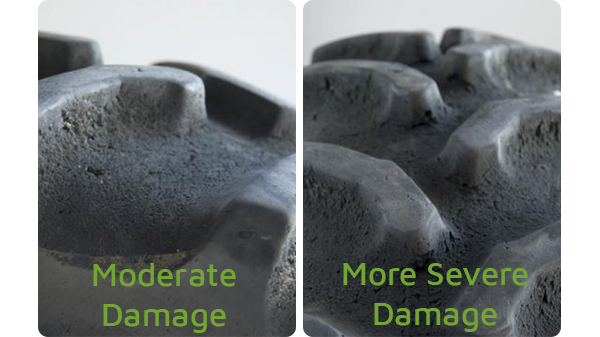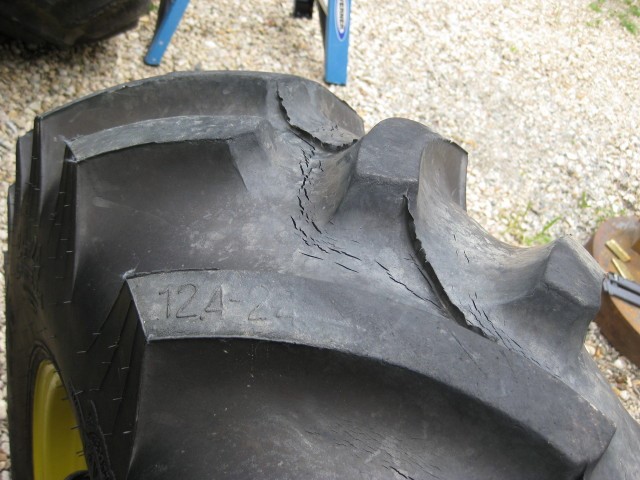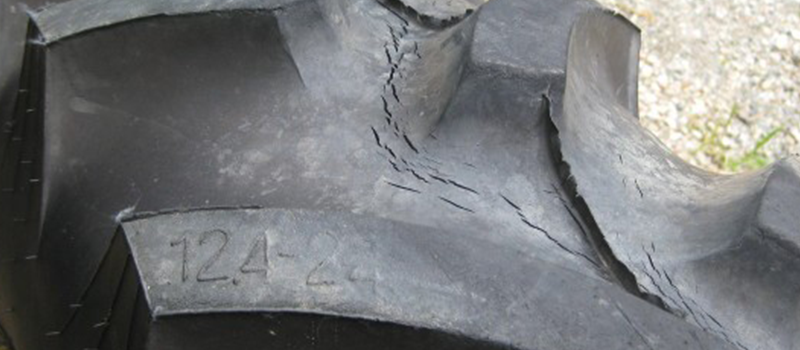Aside from simply knowing a tires remaining tread depth, there are various other factors that can play an important part in determining an appropriate value of used tires and wheels. Let’s discuss what some of these common factors are, as well as review a few tips to help preserve your ag tires and wheels for years to come.
Stubble Damage
For years ag producers have been battling with stubble damage. This problem has become even more relevant in recent years through improved plant genetics and drier conditions causing stalks to become extremely rigid and uncompromising with steel-like strength.
Stubble damage occurs to any tire when stalk remnants repeatedly hit and wear the tread or wall of your tire. Stubble piercing can also occur when strong, sharp stubble punctures the tire, eventually causing air loss.
There are various steps you can take to help reduce stubble damage and prolong the life of your tires. Install stubble mitigation devices, stay between rows, choose stubble resistant command tires, and leave your stalks longer.
Stubble damage is a very common problem particularly in America’s heartland where corn is prevalent. It certainly takes a toll on ag tires and decreases their value.

Weather Checking
The outdoor elements are one of your tires greatest enemies. Sun, rain, snow, freezing/thawing, can all have a negative impact on an ag tires life. “Weathering” or “weather checking” shows up in the form of cracks on a tire. Some can be superficial or very shallow, however, in severe cases cracks can be inches deep.
Because these cracks are a direct result of mother nature, leaving your equipment parked inside (if space permits) when not in use, can dramatically help reduce the progression of, or weather checking ever appearing in the first place.
Weather checking on tires, negatively impact a tires value despite remaining tread percentage and should be factored in during the tire valuation process.

Age of Tire
As covered in more depth in our How To Read The Sidewall of an Ag Tire article, each tire is stamped on one side with a date code. This information tells you what week or what year the tire was manufactured, which can then be used to determine the age of the tire. The date code appears as “0818” which means the tire was made in the 8th week of 2018.
Like farm equipment itself, tires naturally lose value with time. Typically, because the older a tire is, the more hours they have on them (treadwear), weather checking (typically found in older tires), bad/ leaking beads, rusted or corroded rims, and a simple lack of new tire technology such as IF, VF, Radial, CFO/CHO, etc… The date of each tire should be checked and considered.
Demand for Particular Tire
It is important to consider the particular demand for a tire in your region when evaluating tires on trade. Even if the tires are physically in great shape, if a particular producer had unique tires for a specific application, they may not be worth much to anyone else in your area. This should certainly play a factor in your determination of value for tires. Without demand, you may need to purchase other more common tires to put on the machine so it will sell. There is also the hassle of finding someone to buy what you takeoff and the freight expenses to consider moving those tires once you find a buyer outside your region.
Rim/Wheel Damage
Last but not least, the condition of the wheel itself plays a large part in the valuation of a tire. Everything from the color of the wheels are painted, to rust, scale, chips, bends, and cracks which all negatively impact the structural integrity of the wheel. It is also important to know if the wheels are standard for a particular machine, or if they have been replaced with something custom-built for a specific application. While custom-built wheels cost more originally, that does not necessarily make them worth more if you cannot find buyer to utilize the same wheels for a similar application.
Check All of the Tires
Occasionally when customers trade in equipment, tires and/or wheels may be mismatched. For example a Firestone 480/80R50 on the left side of the machine but a Petlas tire on the right. If you get someone who really like Firestone, either the trade-facilitator or customer will need to endure the cost of swapping out that Petlas for a matching Firestone.
Load/Speed Ratings
Some tire manufactures have identical size/models of tires that are available in a lower speed/ load rating and another with a greater speed/load rating. Ensure that not only the tires match, but give value based upon the correct tire.
